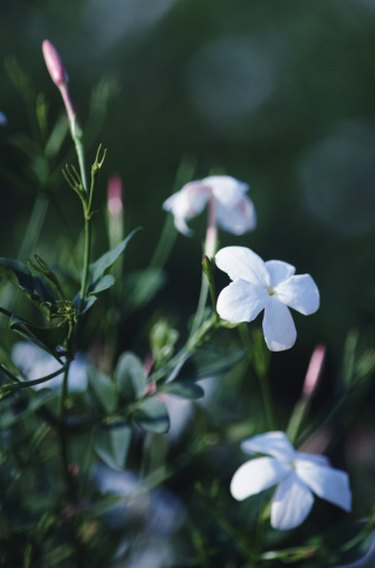
Midnight jasmine is a bushy and scrambling evergreen vine or shrub that is more commonly known as Arabian jasmine. The scientific name for the plant is Jasminum sambac. It is occasionally referred to as midnight jasmine due to its flowers opening up during the night. Midnight jasmine originates in southern and southwestern Asia, in nations such Sri Lanka, India, Myanmar, China (particularly the south region) and the Philippines.
Description
Video of the Day
Midnight jasmine is characterized by its ovate leaves, which are deep green in color. The glossy leaves are approximately 3 inches in length. Midnight jasmine produces clusters of pure white, waxy flowers, which are about an inch long. The long lasting flowers are sweetly aromatic, and gradually fade, with age, to pale pink. The shoots are long and angular. The plants generally range from 6 to 10 feet, with a width of 3 to 5 feet.
Video of the Day
Cultivation
Midnight jasmine grows well under partial shade or full sun. Midnight jasmine is tolerant to frost, but on especially cold evenings requires a measure of protection against it. It also tolerates both humidity and heat. Clay loam and sandy loam soil types are beneficial. Moist soil is ideal, although it is important to avoid waterlogged soil. The plant calls for regular watering, in order to enhance optimal growth. It can be propagated via layering or semi-ripe cuttings from leafy stems. Midnight jasmine blooms from June all throughout the summer, up until September. To keep an attractive shape for the plant, is it crucial to frequently prune.
Common Uses
Midnight jasmine is a popular container houseplant for both outdoor and indoor growth. It is frequently cultivated within a pot, and during the summer months, on either a sundeck or patio. In climates that lack frost, midnight jasmine is commonly seen as a specimen plant or in mixed borders. The plant's dried flowers are also used to produce jasmine tea, by the Chinese. Hawaiians use the flowers to create traditional Hawaiian flower wreaths, which are called "leis." The fragrance of the flower is also often used to produce perfumes, colognes and lotions.